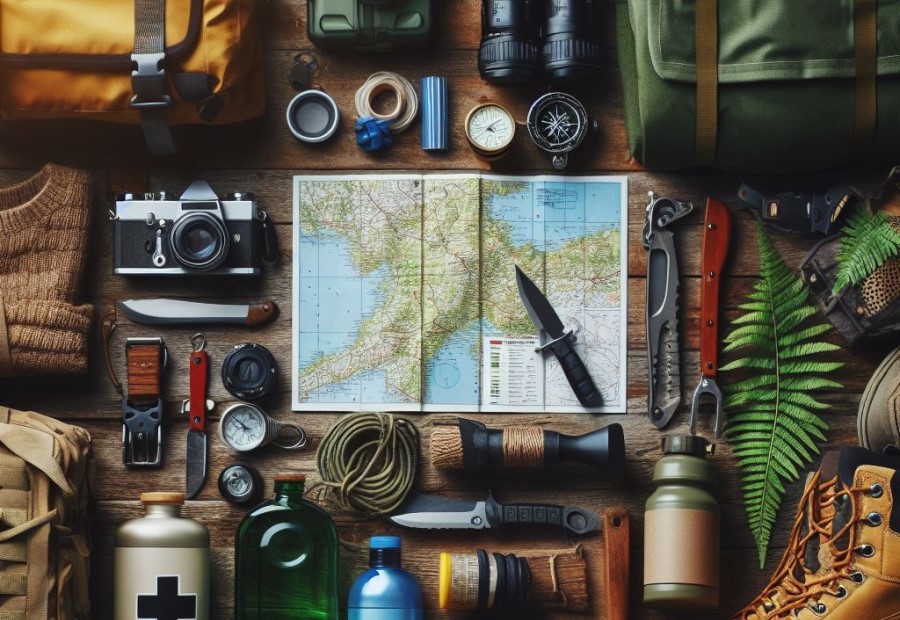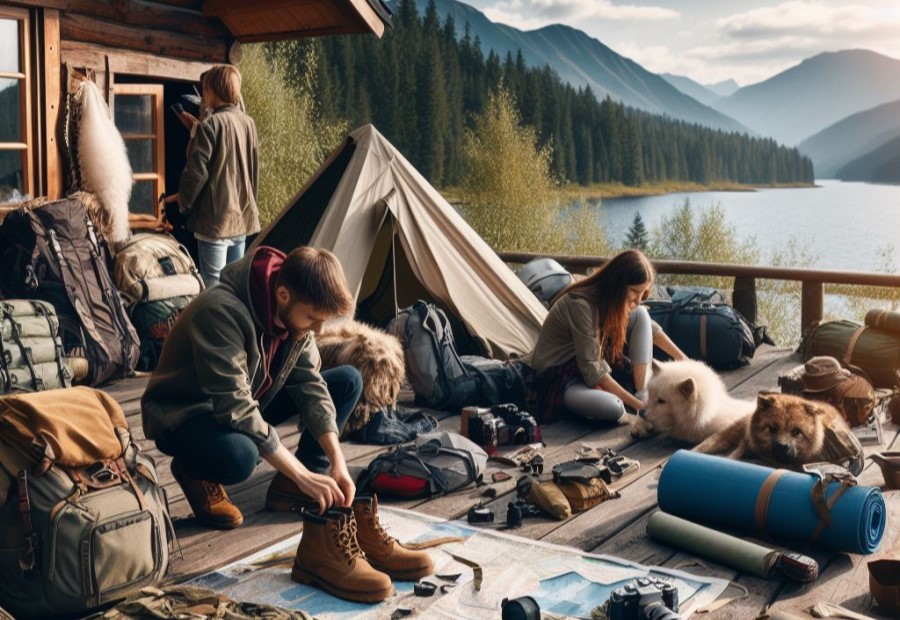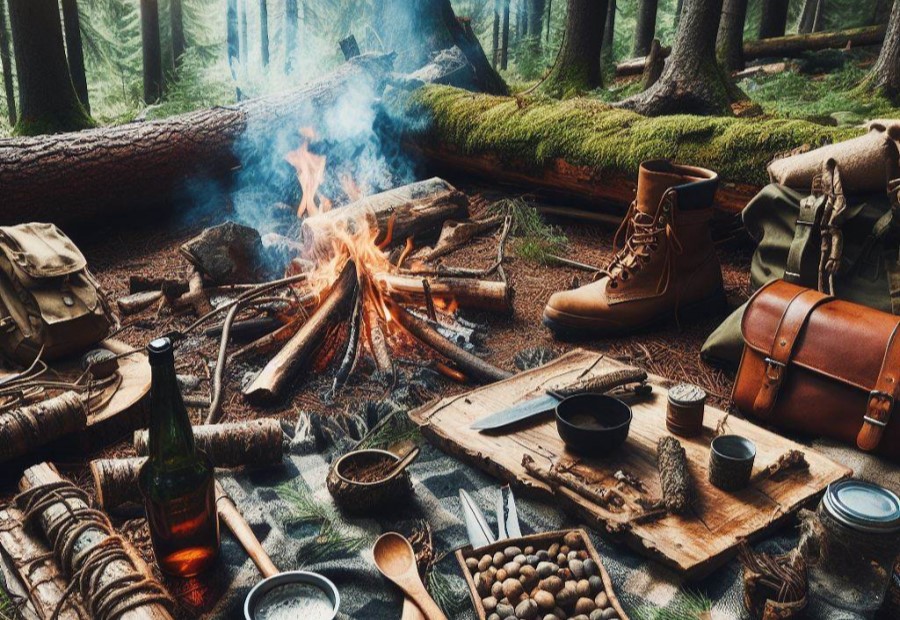Staying safe during a wilderness adventure is paramount to ensuring an enjoyable and risk-free experience. Start by meticulously planning your trip, considering factors such as terrain and weather conditions.
Inform a trusted person about your itinerary and expected return time. Pack essential items, including a map or GPS device, sufficient water and food, appropriate clothing, and a basic first aid kit. Know your physical limits and choose activities that align with your skill level.
Keep an eye on weather forecasts and be prepared for changes in conditions. Follow Leave No Trace principles to minimize environmental impact, and be aware of wildlife, maintaining a safe distance. Hone your navigation skills, stick together as a group, and establish a buddy system.
Carry emergency essentials like a whistle, signaling devices, and a charged phone. If water activities are involved, use a life jacket and exercise caution. By prioritizing preparedness, responsibility, and knowledge, you can enhance your safety while immersing yourself in the beauty of the wilderness.
Tips for Staying Safe during a Wilderness Adventure
When embarking on a wilderness adventure, it’s crucial to prioritize safety to ensure a successful and enjoyable experience. Here are some important tips for staying safe during a wilderness adventure:
- Plan ahead: Research and prepare for the specific wilderness area you will be visiting. Understand the terrain, weather conditions, and potential risks.
- Inform others: Share your trip details with a trusted friend or family member. Provide them with your itinerary, expected return date, and emergency contact information.
- Pack essentials: Always carry essential items such as a map, compass, first aid kit, extra food, water purification methods, and appropriate clothing for unpredictable weather.
- Stay hydrated: Drink water regularly to prevent dehydration. The recommended intake is at least 2 liters per day, but it may vary depending on the climate and activity level.
- Use proper gear: Invest in sturdy and appropriate gear for outdoor activities. Ensure that your footwear fits well and provides adequate support.
- Be aware of wildlife: Research the wildlife in the area and understand their behaviors. Keep a safe distance, store food securely, and avoid surprising or provoking animals.
- Follow trail markers: Stick to established trails and follow markers or signs to avoid getting lost. If you do find yourself lost, stay calm, backtrack to the last known point, and seek help if necessary.
- Practice fire safety: If allowed, carefully manage campfires and ensure they are fully extinguished before leaving. Follow any fire restrictions or regulations in the area.
- Leave no trace: Minimize your impact on the environment by practicing proper waste disposal, respecting wildlife and vegetation, and leaving natural items as you found them.
- Emergency preparedness: Carry a whistle or signaling device for emergencies. Familiarize yourself with basic first aid procedures, and know how to navigate using a map and compass.
What to Pack for a Wilderness Adventure?

Essentials for Navigation
- A detailed and up-to-date map is essential for navigation in the wilderness. It should include topographic features, trails, and landmarks.
- A reliable compass is crucial for determining directions and orienting yourself on the map.
- A GPS device can provide accurate coordinates and help track your progress. Make sure to have extra batteries or a power source for longer trips.
- Utilize navigation apps on your smartphone as a backup option, but keep in mind that they may not always be reliable in remote areas without cellular service.
- Use markers or waypoints to note important locations, such as campsites, water sources, or trail junctions. These can help you stay on track.
- Carry a reliable headlamp or flashlight with extra batteries in case you need to navigate in the dark or during low-light conditions.
- An altimeter can help you determine your elevation and aid in identifying landmarks or determining your location on the map.
- It is crucial to have the knowledge and skills required to interpret maps, understand contour lines, and navigate using compass bearings.
Safety Gear and First Aid Kit
When venturing into the wilderness, it is crucial to have the right safety gear and first aid kit to ensure your well-being. Here is a list of essential items you should include in your backpack:
- First Aid Kit: Carry a well-stocked first aid kit containing bandages, gauze pads, adhesive tape, antiseptic wipes, and any necessary medication. Be prepared for common injuries such as cuts, scrapes, burns, and sprains.
- Emergency Shelter: Pack items like a lightweight emergency blanket or a tarp to protect you from the elements in case of unexpected circumstances or getting lost.
- Whistle: A whistle can be a handy tool to alert others of your location in case of an emergency. It can also help scare away wildlife if needed.
- Navigation Tools: Carry a map and compass to navigate your way through the wilderness accurately. Familiarize yourself with these tools before your trip to ensure you can use them effectively.
- Fire Starters: Include waterproof matches or a reliable fire starter kit to help you build a fire for warmth, cooking, or signaling for help if necessary.
- Knife or Multi-tool: Having a versatile tool can be invaluable in various situations, from cutting ropes to repairing gear. Choose a high-quality, durable option.
- Extra Food and Water: Always carry extra food and water to sustain yourself in case of delays or emergencies. Pack lightweight, non-perishable food items and remember to stay hydrated.
- Headlamp or Flashlight: These are essential for illuminating your way in low light conditions or during nighttime emergencies.
- Personal Protection: Depending on your destination, consider carrying items such as insect repellent, sunblock, and a hat to protect yourself from bugs and harmful sun rays.
Remember, proper preparation and having the right safety gear and first aid kit can significantly contribute to your safety and well-being during a wilderness adventure.
Proper Clothing and Footwear
Proper clothing and footwear are essential considerations for any wilderness adventure. Take note of the following recommendations:
- Layered Clothing: To adapt to changing temperatures, it is crucial to dress in layers. Start with a moisture-wicking base layer, add insulating layers for warmth, and top it off with a waterproof and breathable outer layer.
- Durable Pants and Shorts: Choose pants or shorts made of durable and quick-drying materials to withstand rough terrains. Look for options that have reinforced knees and seat for extra durability.
- Sturdy Boots: Invest in a pair of sturdy, waterproof hiking boots with ankle support. Good grip and traction are vital for safely navigating various terrains. Make sure to break them in before your adventure to prevent blisters.
- Comfortable Socks: Opt for moisture-wicking and cushioned socks to avoid blisters and keep your feet dry and comfortable throughout the journey.
- Protective Headwear: Shield your face and eyes from the sun by wearing a wide-brimmed hat or a cap. In colder weather, go for a beanie or a hat that covers your ears.
- Proper Footwear: Take into account the activities you’ll engage in during your wilderness adventure. If you plan on crossing wet areas or bodies of water, pack water shoes or sandals with good traction.
- Gloves: Depending on the weather conditions and activities, remember to pack a pair of lightweight gloves for protection and warmth.
Adequate Food and Water
When embarking on a wilderness adventure, it is crucial to ensure you have enough food and water to sustain yourself. Adequate food and water are essential for your journey. Here are important considerations to keep in mind:
1. Pack enough food: Bring a sufficient amount of non-perishable food items to last for the duration of your trip. Plan your meals according to the number of days and the level of physical activity. Adequate food will help maintain your energy levels and provide the necessary nutrients for your body.
2. Choose calorie-dense foods: Opt for foods that are high in calories to provide the energy needed for outdoor activities. Nut butter, granola bars, dried fruits, and trail mix are excellent options. These foods offer a balance of carbohydrates, fats, and proteins to keep you satiated and nourished.
3. Consider water sources: Research the availability of water sources along your route and plan accordingly. Adequate water is crucial for staying hydrated. Carry a water filtration system or purification tablets to ensure access to safe drinking water. Staying hydrated is vital for maintaining overall well-being and preventing dehydration.
4. Stay mindful of water intake: Drink regularly throughout the day, even if you don’t feel thirsty. Adequate water intake is vital, especially in demanding outdoor environments. Aim to consume at least 2-3 liters of water per day to replenish what is lost through sweat and physical exertion.
5. Pack additional snacks: In addition to your main meals, pack extra snacks like energy bars, nuts, and jerky to keep your energy levels up between meals. These snacks are convenient and provide quick bursts of energy when needed.
By considering these factors and ensuring you have adequate food and water, you can stay nourished and energized during your wilderness adventure. Remember to pack responsibly and leave no trace of your presence in nature.
Choosing the Right Wilderness Adventure

Research the Terrain and Weather
When planning a wilderness adventure, it’s crucial to research the terrain and weather conditions to ensure a safe and enjoyable experience.
- Study the topography of the area you will be exploring. Determine if it consists of mountains, forests, deserts, or other types of landscapes.
- Research the climate and weather patterns of the region. Find out about average temperatures, precipitation levels, and any potential weather hazards such as hurricanes or extreme heat.
- Check if there are any specific seasonal considerations you need to be aware of, such as monsoon seasons or heavy snowfall during winter.
- Look into the availability and reliability of water sources in the area. Consider if you’ll need to carry extra water or rely on purification techniques.
- Identify any potential natural hazards such as wildlife encounters, poisonous plants, or steep cliffs.
Pro-tip: It’s important to stay flexible and be prepared for unexpected changes in the terrain and weather. Always have a backup plan and carry appropriate gear to handle different conditions.
Consider Your Physical Fitness Level
When planning for a wilderness adventure, it is important to consider your physical fitness level to ensure a safe and enjoyable experience.
- Evaluate your current fitness level and stamina. Consider whether you have the strength, endurance, and flexibility necessary to handle the physical demands of a wilderness adventure.
- Assess your cardiovascular fitness. Keep in mind that wilderness adventures often involve hiking, climbing, or other strenuous activities that require a good heart and lung capacity.
- Take into account your strength and muscular endurance. Depending on the type of adventure, you may need to carry a heavy backpack, climb steep trails, or engage in activities that require upper body strength.
- Consider your agility and balance. Remember that wilderness environments can be rugged and uneven, so having good balance and agility will help prevent accidents and injuries.
- Manage any existing medical conditions. If you have any pre-existing health conditions, it is important to consult with a healthcare professional to determine if they may affect your ability to engage in a wilderness adventure.
By considering your physical fitness level, you can better prepare yourself for the physical demands of a wilderness adventure and ensure a safe and enjoyable experience.
Planning and Preparing for a Wilderness Adventure

Create a Detailed Itinerary
When planning a wilderness adventure, it is crucial to create a detailed itinerary in order to ensure a safe and organized trip. Here are the steps to create a detailed itinerary:
- Research the area: It is important to gather information about the location, including maps, trail conditions, and any permits required.
- Determine the duration: Decide how long you will be staying in the wilderness and plan your itinerary accordingly.
- Identify key points of interest: Make sure to highlight the must-visit spots, such as scenic viewpoints or landmarks, along your route.
- Set daily goals: Break down your itinerary into daily segments, determining how far you plan to hike or travel each day.
- Allocate time for breaks: It is important to allow sufficient time for rest, meals, and other activities, ensuring a balance between exploration and relaxation.
- Consider weather and terrain: Take into account the weather conditions and the difficulty of the terrain when planning your itinerary, and make necessary adjustments.
- Incorporate safety measures: Include checkpoints for checking in with someone reliable and leaving a copy of your itinerary with them.
- Be flexible: While having a detailed itinerary is important, it is also important to be open to changes and adapt your plans if needed, considering unforeseen circumstances or unexpected delays.
Check-In with Someone Reliable
When embarking on a wilderness adventure, it is crucial to prioritize your safety by checking in with someone reliable. Here are some compelling reasons why:
- Enhanced Accountability: By sharing your adventure plans with a trustworthy individual, they will have knowledge of your whereabouts and expected return time. This guarantees that if any unforeseen circumstances arise, they can promptly take appropriate action.
- Efficient Emergency Response: In the unfortunate event of an emergency or encountering challenges during your excursion, someone who is aware of your plans can quickly initiate a search and rescue operation or offer much-needed assistance.
- Mental Well-being Support: Having the assurance that someone is informed about your trip and eagerly waiting for your communication can provide profound peace of mind. This not only boosts your confidence but also allows you to fully immerse yourself in the awe-inspiring wilderness experience.
- Alleviating Concern: Informing a dependable individual about your adventure can alleviate unnecessary worry. They can find solace in knowing that you are taking precautions and adequately prepared for any potential obstacles.
- Timely Adaptation: If unexpected delays or modifications to your plans occur, keeping in touch with someone reliable enables them to adjust their expectations and patiently await your safe return.
Familiarize Yourself with Local Regulations and Wildlife
When embarking on a wilderness adventure, it is crucial to familiarize yourself with local regulations and wildlife for your own safety. Here are the steps you should take:
- Research local regulations: Take the time to familiarize yourself with the specific rules and regulations of the wilderness area you will be exploring. This includes permits, camping restrictions, and any prohibited activities. By doing so, you will ensure that you are in compliance with the regulations.
- Study wildlife information: Educate yourself about the native species, their habitats, and behavior. This knowledge will help you understand how to safely interact with wildlife and avoid any potential conflicts.
- Learn about endangered species: It is important to be aware of any endangered species in the area to prevent accidental harm or disturbance. Make sure you are well-informed about the protected species and take the necessary precautions to preserve their habitats.
- Know how to store food: Understand the proper food storage techniques to prevent attracting wildlife. Keep your food securely stored in bear-proof containers or hang it in a designated area where animals cannot access it.
- Practice responsible waste disposal: Take measures to dispose of your waste in a responsible manner to avoid negative impacts on the environment and wildlife. Always carry out all trash and dispose of it properly, following designated areas or adhering to leave-no-trace principles.
- Stay updated on weather conditions: Keep yourself informed about weather forecasts and any alerts or warnings related to the area you will be exploring. This will help you adequately prepare and make informed decisions during your adventure.
Wilderness Survival Skills to Learn

Navigation and Map Reading
When venturing into the wilderness, having navigation and map reading skills is crucial for ensuring your safety and finding your way.
Here are some important aspects to consider:
- Learn to read topographic maps: Familiarize yourself with symbols, contour lines, and elevation changes, which will help you understand the terrain.
- Use a compass: Knowing how to use a compass properly is essential for determining direction and orienting yourself on the map.
- Pay attention to landmarks: Identifying prominent natural features like mountains, rivers, or unique rock formations can serve as reference points for navigation.
- Track your progress: Continuously monitor your position on the map by keeping track of landmarks and using intersecting lines or compass bearings.
- Plan your route: Before setting out, plan your intended route, taking into account distance, elevation changes, and potential obstacles.
By improving your navigation and map reading abilities, you can confidently explore the wilderness, discover new areas, and navigate safely back to civilization.
Fire Building and Campsite Setup
To effectively build a fire and set up a campsite in the wilderness, follow these steps:
- Gather dry firewood: Look for dry branches, twigs, and logs to use as fuel for your fire. Avoid using green wood as it will be difficult to light and produce more smoke.
- Create a fire pit: Clear an area on the ground, free from any flammable materials, to establish a fire pit. Dig a shallow hole and surround it with rocks.
- Arrange the firewood: Begin by placing a few small twigs or leaves at the bottom of the fire pit as tinder. Then, layer small sticks and gradually increase the size to create a small teepee shape.
- Ignite the fire: Use matches or a lighter to ignite the tinder. Blow gently on the flames to help them grow. Add more small sticks to ensure a steady fire.
- Maintain the fire: Continuously add larger pieces of firewood to keep the fire burning. Make sure you have enough wood to last throughout the night.
- Establish a safe campsite: Choose a flat area with soft ground to set up your tent. Remove any rocks, sticks, or debris that could cause discomfort or damage to your tent. Make sure there are no overhanging branches or potential hazards nearby.
- Pitch your tent: Follow the instructions included with your tent to properly assemble it. Secure the tent with stakes and guy lines to ensure stability, especially in windy conditions.
- Arrange your camping gear: Set up your sleeping bags or mats inside the tent. Organize your cooking utensils, food, and other camping essentials in a designated area.
- Be mindful of fire safety: Keep a safe distance between your campsite and the fire pit. Never leave the fire unattended and fully extinguish it before leaving your campsite or going to sleep.
By following these steps, you can safely build a fire and set up a comfortable campsite during your wilderness adventure. Remember to always prioritize safety and adhere to any local regulations regarding fire use.
Water Purification Techniques
When it comes to staying safe during a wilderness adventure, knowing proper water purification techniques is crucial. This ensures that you have a clean and safe water source to stay hydrated.
| Boiling | Boiling water is one of the most effective water purification techniques. Bring the water to a rolling boil for at least one minute to kill harmful bacteria, viruses, and parasites. |
| Chemical Treatment | Chemical treatment is another method of water purification. It involves using water purification tablets or liquid drops that contain chlorine, iodine, or chlorine dioxide. Follow the instructions on the packaging for proper dosage and wait time. |
| Filtration | Using water filtration systems or portable water filters is an effective technique for water purification. These devices can remove bacteria, protozoa, and some viruses from water. Look for filters with a pore size small enough to catch these contaminants. |
| UV Light Treatment | UV light treatment is a modern technique for water purification. UV light treatment devices use ultraviolet light to kill microorganisms in water. These portable devices can be used to treat small amounts of water at a time. |
| Distillation | Distillation is a traditional water purification technique. It involves boiling water and collecting the steam, which is then condensed back into liquid form. This process effectively removes impurities and contaminants. |
Before using any water purification method, it’s important to carefully read and follow the instructions provided with the specific product or device. Additionally, be aware of the water sources available in the wilderness and choose the cleanest possible option for treatment.
Dealing with Wildlife Encounters

Understanding Animal Behavior and Habitats
Understanding animal behavior and habitats is crucial for staying safe during a wilderness adventure. Here are some key factors to consider:
1. Study animal behavior: Familiarize yourself with the behaviors of different animals you may encounter in the wilderness. Understand their territorial boundaries, feeding patterns, and warning signs of aggression. This knowledge will help you avoid conflicts and stay safe.
2. Recognize habitats: Learn about the habitats where different animals reside. Research their preferred territories, nesting areas, and hiding spots. This understanding will help you navigate the wilderness more effectively and avoid accidental encounters.
3. Respect their space: Maintain a safe distance from wildlife and respect their natural habitat. Observing animals from afar is the best way to preserve their natural behavior and ensure your own safety.
4. Proper food storage: Keep your food securely stored and away from wildlife. Animals have a keen sense of smell and can be attracted to food. Proper food storage not only protects you from wildlife encounters but also prevents damage to the ecosystem.
5. Leave no trace: Practice Leave No Trace principles by avoiding actions that may disturb or alter animal habitats. Minimize your impact on the environment and maintain the delicate balance of wildlife habitats.
Proper Food Storage and Waste Disposal
When embarking on a wilderness adventure, it is crucial to consider proper food storage and waste disposal. These practices are essential for preserving the environment and preventing encounters with wildlife.
- To keep your food safe from wildlife, store it in airtight containers or bear-resistant canisters. This will prevent animals from being attracted to your campsite.
- Elevate your food storage by hanging food bags or using bear poles. This will keep it out of reach of animals.
- Ensure proper disposal of food waste by packing it out. Remember not to leave any food scraps behind, as they can attract animals and disrupt the natural balance of the ecosystem.
- For dishwashing, use biodegradable soap and dispose of the wastewater at least 200 feet away from water sources. This helps in preventing contamination and protects the water quality.
- Adhere to the Leave No Trace principles by packing out all non-biodegradable waste, such as wrappers, cans, and bottles. Leave the wilderness as you found it.
- Consider reducing packaging waste by repackaging food into reusable containers or opting for dehydrated meals.
Proper food storage and waste disposal practices are not only crucial for your own safety but also for the well-being of the environment and wildlife inhabiting the wilderness. By following these guidelines, you can ensure a responsible and enjoyable wilderness adventure.
Responding to Different Wildlife Situations
When encountering wildlife during a wilderness adventure, it is important to know how to respond to different situations. Here are some guidelines to follow:
- It is crucial to remain calm when encountering wildlife. Panicking or making sudden movements can provoke animals and potentially lead to an attack.
- Assess the situation: Evaluate the behavior of the animal and the distance between you and the wildlife. If the animal appears aggressive or is approaching you, slowly back away while keeping eye contact.
- Do not feed or approach: Never approach or attempt to feed wild animals. This can disrupt their natural behavior and create dangerous situations for both you and the animal.
- Make yourself seem larger: In the case of an aggressive encounter, try to make yourself appear larger by raising your arms or opening your jacket. This can intimidate the animal and discourage an attack.
- Use noise and deterrents: If an animal continues to approach, make loud noises, clap your hands, or use deterrents like bear spray for bears. These tactics can scare off the wildlife.
- Keep a safe distance: It is important to maintain a safe distance from wildlife. This not only protects you but also ensures the animals are not disturbed or stressed.
- Respect their space: Remember that you are a visitor in their natural habitat. Respect the wildlife and observe from a distance without interfering or intruding on their environment.
- Report any incidents: If you encounter a dangerous situation or witness wildlife behaving unusually, report it to the appropriate authorities or park rangers. This helps ensure the safety of both visitors and the wildlife.
Handling Wilderness Emergencies

First Aid and Basic Medical Skills
When venturing into the wilderness, having first aid and basic medical skills is crucial for staying safe and handling emergencies. Here are some essential skills to learn:
- Assessing injuries and providing initial care
- Cleaning and dressing wounds properly
- Understanding signs of dehydration and managing it effectively
- Recognizing and treating common outdoor injuries like sprains, strains, and insect bites
- Administering CPR and basic life support techniques if necessary
These skills can significantly improve your ability to respond to medical emergencies in the wilderness and ensure the well-being of yourself and others.
Fun Fact: Studies have shown that immediate and proper first aid and basic medical skills can significantly increase the chances of survival and positive outcomes in wilderness emergencies.
Creating SOS Signals and Rescue Techniques
To ensure your safety during a wilderness adventure, it is crucial to understand how to incorporate rescue techniques and create SOS signals. Here are the steps to follow:
- Build a fire: To attract attention from a distance, construct a fire that produces thick smoke using green vegetation in an open area.
- Use a whistle or mirror: Always carry a whistle or mirror in your survival kit. Three loud whistle blasts or reflecting sunlight with a mirror can assist rescuers in locating you.
- Set up visual signals: Utilize bright-colored clothing or tarps to create visible markings on the ground or trees, making it easier for search teams to spot your location.
- Create an SOS signal: Arrange rocks or logs in a large “SOS” formation that can be easily seen from the air. Ensure its size is sufficient to catch the attention of passing planes or helicopters.
- Use a signal mirror: If you possess a signal mirror, direct it towards the aircraft or ground search team and flash reflected light in their direction. This will aid in attracting attention.
- Write distress messages: Utilize sticks, rocks, or any available resources to write prominent distress messages on open ground that convey your need for rescue.
- Stay in an open area: Whenever feasible, relocate to an open area where you can be easily spotted from the air or ground. Avoid dense vegetation or areas that may impede search efforts.
- Maintain a positive attitude: Remain calm, conserve your energy, and be patient. Rescuers are trained to locate and assist individuals in distress, so keep hope alive.

